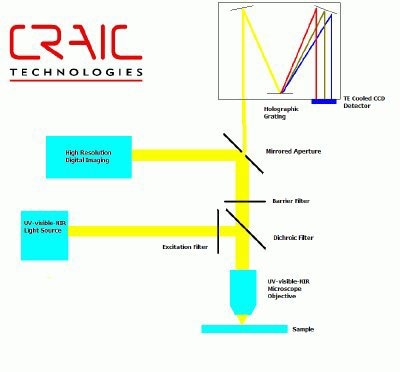CRAIC Technologies is the worlds leading developer of UV-visible-NIR range scientific instruments for microanalysis. These include the 2030PV PRO™ UV-visible-NIR microspectrophotometer designed to help you non-destructively measure the optical spectra of microscopic samples. CRAIC's UVM-1 deep ultraviolet microscopes cover the UV, visible and NIR range and help you analyze with sub-micron resolutions far beyond the visible range. CRAIC Technologies also has the Apollo M confocal Raman microspectrometer for non-destructive analysis of microscopic samples. And don't forget that CRAIC proudly backs our microspectrometer and microscope products with unmatched service and support.
What is a Microspectrophotometer
The UV-visible-NIR microspectrophotometer is designed to measure the spectrum of microscopic areas or microscopic samples. It can be configured to measure the transmittance, absorbance, reflectance, polarization and fluorescence of sample areas as smaller than a micron.
Design and Components of Microspectrophotometer
The microspectrophotometer is sometimes called a microscope spectrophotometer as it combines an optical microscope and a highly sensitive spectrophotometer. In actuality, the microspectrophotometer is a fully integrated, purpose built instrument while the microscope spectrophotometer is an add-on component for a standard microscope. As such, add-on components have certain performance limitations due to the microscope itself. An integrated instrument avoids those limitations as it is designed specifically for microspectroscopy.
In a microspectrophotometer, such as those made by CRAIC Technologies, the spectrophotometer is integrated with a specially designed microscope. The microscope optics and light sources are of the highest quality and able to operate in the ultraviolet, visible and near infrared regions (normal microscopes only operate in the visible range). The spectrophotometer is built into the microscope, along with a digital imaging system, so that the maximum amount of light can be collected from the smallest samples. As such, microspectrophotometers are very flexible instruments able to measure absorbance, transmittance, reflectance, and emission (such as fluorescence) spectra of even sub-micron sized samples.

Image Credit: The 2030PV PRO™ UV-VIS-NIR microspectrophotometer from CRAIC Technologies. This instrument can be configured for transmission, reflectance, photoluminescence and Raman spectroscopy and imaging
How Microspectrophotometer Works
The microscope spectrometer and microspectrometer work like this: a lamp on the microscope emits white light which is focused onto the sample. The sample absorbs some wavelengths of light better than others...it all depends upon the sample chromophore's chemical structure and environment. The light not absorbed is collected by the microspectrophotometer objective and focused onto the entrance aperture of the spectrophotometer. As the aperture is mirrored, the majority of light is reflected into a digital imaging system. This allows you to see the spectrophotometer aperture overlaid on the sample and makes it very easy to align the system and take spectra. Figure 1 shows the entrance aperture as a black square. Simply move the stage so that the square is over the sample to make measurements.

Figure 1. Simultaneous image of sample with microspectrometer aperture
The light that is not reflected into the digital imaging system will pass through the aperture into the spectrophotometer. The light is separated into component wavelengths by an optical grating and each component's intensity is measured by a pixel on a Charge Coupled Device or CCD detector. The computer stores this information and the result is an optical spectrum. This spectrum is plotted as an XY chart that shows the optical energy at each wavelength (Figure 2).

Figure 2. Absorbance microspectra testing single pixels of a LCD display
Different types of microspectroscopy are accomplished by different lighting techniques. These techniques are determined by the samples themselves. For example, incident or reflectance illumination is used for opaque samples whereas transmitted light is used for transparent samples. A microspectrophotometer can be configured to measure transmission, absorbance, reflectance and emission spectra.

Figure 3. General diagram of a transmission microspectrophotometer

Figure 4. General diagram of a reflectance microspectrometer

Figure 5. General diagram of a microfluorometer
In operation, a measurement is straightforward. One first takes a dark scan to measure the dark counts of the system The spectrum from a reference material is then collected. The reference spectrum contains the spectral characteristics of the reference material itself, the light sources, the optics and the CCD. The spectrum from the sample is then acquired and an algorithm is used to calculate the appropriate spectra for that lighting condition i.e. reflectance spectra when measuring incident illumination. The algorithm is automatically applied by the computer and the result is displayed as a spectrum.

This information has been sourced, reviewed and adapted from materials provided by CRAIC Technologies.
For more information on this source, please visit CRAIC Technologies.